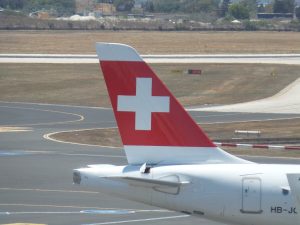Swiss has discovered that the protective breathing equipment (PBE), which is intended to protect crews from smoke and fumes in the unlikely event of smoke development on board, is partially defective. The airline immediately informed the responsible authorities and is now gradually replacing the affected protective equipment. In order to ensure the safety of the crews during this exchange phase, Swiss experts have, among other things, created an updated training program.
Swiss International Air Lines crew members have access to various pieces of equipment on all aircraft to protect them from smoke and fumes, for example in the unlikely event of smoke development. In particular, the so-called Protective Breathing Equipment (PBE) serves as a protective mask for employees in the cabin and cockpit. These masks are equipped with oxygen generators so that breathing is possible even when there is smoke in the cabin and the crew members can move freely. Two different internationally certified models are installed on Swiss aircraft.
In the recent past, crew members on two Swiss flights noticed unusual odors and put on their PBE as a preventive measure. Some of the masks did not work properly or were difficult to remove from the packaging. At no time was there any danger to the crew or passengers; both flights were able to land safely and in a controlled manner.
Swiss immediately reported the incidents to the responsible authorities, the Federal Office of Civil Aviation (FOCA) and the Safety Investigation Board (SUST), and took measures to ensure the optimal handling of the protective equipment.
Respiratory masks are being replaced
Experts from various specialist departments at Swiss examined the respiratory masks again in detail and found that the functionality of one of the two models was actually partially limited. Even if the lack of operational readiness was not evident in all PBE masks tested, Swiss took the preventive decision to replace all models of this type. The procurement of new models has already been initiated and will be implemented as quickly as possible.
Since Swiss has installed almost 1.000 respiratory masks of the affected type in its aircraft, the replacement process will take a few months. That's why Swiss has now initiated an additional training program for all crews. For example, it is intended to raise crews' additional awareness of the special handling of this type of mask.




